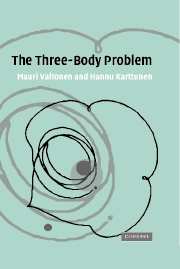Book contents
- Frontmatter
- Contents
- Preface
- 1 Astrophysics and the three-body problem
- 2 Newtonian mechanics
- 3 The two-body problem
- 4 Hamiltonian mechanics
- 5 The planar restricted circular three-body problem and other special cases
- 6 Three-body scattering
- 7 Escape in the general three-body problem
- 8 Scattering and capture in the general problem
- 9 Perturbations in hierarchical systems
- 10 Perturbations in strong three-body encounters
- 11 Some astrophysical problems
- References
- Author index
- Subject index
8 - Scattering and capture in the general problem
Published online by Cambridge University Press: 04 December 2009
- Frontmatter
- Contents
- Preface
- 1 Astrophysics and the three-body problem
- 2 Newtonian mechanics
- 3 The two-body problem
- 4 Hamiltonian mechanics
- 5 The planar restricted circular three-body problem and other special cases
- 6 Three-body scattering
- 7 Escape in the general three-body problem
- 8 Scattering and capture in the general problem
- 9 Perturbations in hierarchical systems
- 10 Perturbations in strong three-body encounters
- 11 Some astrophysical problems
- References
- Author index
- Subject index
Summary
Three-body scattering
Three-body scattering is a process where a third body comes from a large distance in a hyperbolic orbit and interacts with a binary. The interaction may result in a capture of the third body into the vicinity of the binary. Then we say that a resonance (a long lasting state, as in atomic physics) has formed. We expect that the resonance will finally end with an escape of one of the bodies. The other alternatives are an exchange where the interaction leads to an immediate expulsion of one of the binary members, or a flyby when the third body immediately leaves the scene of the close interaction with the binary. These processes will be discussed in turn, in the following sections. Here the basic theoretical groundwork is formulated, using the results from Section 7.1. At very high energies the three bodies may fly apart separately; then the process is called ionisation.
Sometimes a different definition of exchange is used: whenever one of the original binary members is ejected, the process is called exchange. It may happen immediately (prompt exchange) or after an intermediate resonance (resonance exchange). We do not follow this wider definition but define exchange as prompt exchange.
The calculation of the scattering process is performed in two steps: (1) the probability that the third body meets the binary is calculated, and (2) the probability that the binary gains or loses a given amount of energy in the interaction with the third body is estimated.
- Type
- Chapter
- Information
- The Three-Body Problem , pp. 197 - 220Publisher: Cambridge University PressPrint publication year: 2006

